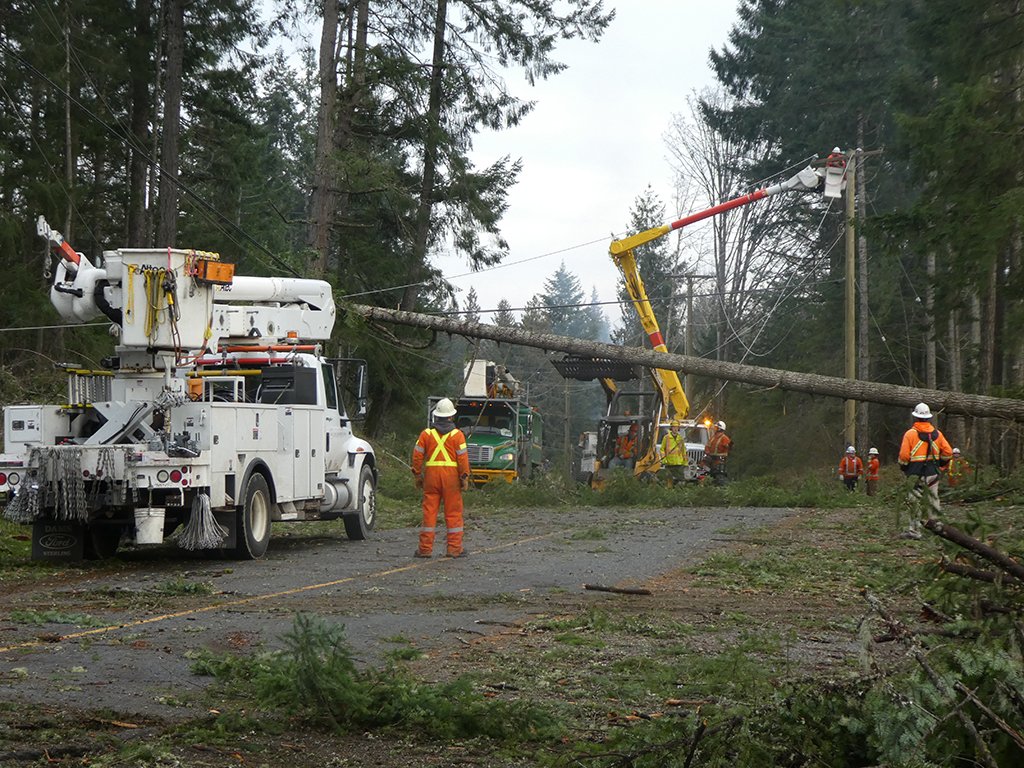
When the power went out in the small community of Lake Cowichan, B.C., during a destructive windstorm that swept the province’s coast on Thursday, many residents weren’t prepared for it to stay out indefinitely.
Mayor Rod Peters says he spent Saturday “running around” town and preparing to open the local school so his constituents could shower or warm up with a hot cup of coffee, tea or cocoa.
“We have several broken power lines in between Duncan and Lake Cowichan,” Peters said in an interview. “It’s a major job.”
While many Lake Cowichan residents have backup generators, Peters said others have been left completely in the dark.
“It’s very bad for our senior population if they have nothing in the way of backup,” he said.
While several BC Hydro trucks have pulled through town, Peters said he’s been advised that power might not be fully restored in the community of roughly 3,000 before Monday morning.
Thursday’s windstorm was the worst that BC Hydro has seen in 20 years, and strong gusts continued Saturday, prompting BC Ferries to cancel several sailings and municipalities like Nanaimo to close parks and trails until further notice.
Environment Canada issued a wind advisory for many parts of Vancouver Island and the coast Saturday, projecting gusts up to 90 kilometres per hour.
BC Hydro said in a statement that 600,000 customers lost power in British Columbia’s southwest because of the storm and 66,000 remained without power Saturday afternoon.
“Hundreds of downed trees have left some roads impassable, which means BC Hydro has not been able to complete full damage assessments in some of the worst-hit areas” including Lake Cowichan, it said.
“Due to the extent of the damage, some of the hardest-hit areas will be without power for several more days.”
More than 800 field personnel will continue to work around the clock to get electricity back up, the utility said.
“There are hundreds of individual outages that crews must attend to individually to make complicated and lengthy repairs,” it said.
“For example, replacing a damaged power pole is considered a mini construction job and can take up to eight hours.”
BC Hydro reminded customers to consider food safety, saying a fully packed freezer will hold food safely for two days, while food in a half packed freezer will keep for one. And it said that while home generators can be useful during a power outage, they can also be very dangerous. It advised people never to use a portable generator or outdoor barbecue indoors, and never to store fuel inside.
The storm left a path of destruction. One woman died Thursday when a tree fell on the tent she was sharing with four other people in Duncan. Two others in the tent were injured, one of whom was airlifted to hospital while the other was taken by ambulance.
Boats broke loose from their moorings and battered White Rock’s beloved pier, causing the midsection to collapse Thursday. One person was trapped at the end of the pier and had to be airlifted by helicopter to safety.
The storm also caused a breakdown of Nanaimo’s water treatment plant, prompting the city to urge residents to conserve water so there would be enough for emergency firefighting services.
Full service returned early Saturday evening, after staff traced the issue to a control device within the plant that malfunctioned during the power outage.
Nanaimo also opened a “warming centre” for residents without power.
“Our volunteers are ready to welcome residents without power to Beban Park Social Lounge to warm up and charge their phones,” Karen Lindsay, emergency program co-ordinator, said in a statement.